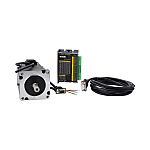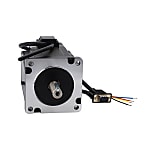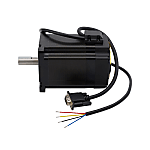(!)NOTE : Windows 7 users won’t be able to use some latest features of eCatalog/WOS since Microsoft is ending support for Windows 7 on 14 Jan, 2020. Please upgrade your system for uninterrupted services.
- Scheduled Maintenance Notice: This site will be unavailable due to scheduled maintenance from 6:30 24/11/2024 to 4:30 (IST) 25/11/2024. We apologize for the inconvenience.
- Please note that the MISUMI Pune office and warehouse will be closed on November 20th due to the state election.
- Notice of End of Sales for Economy Series Pneumatic Equipment Category. More information.
Stepping Motors
The Stepping motor is an electro-mechanical device that converts electrical pulses into precise mechanical movements. Stepping motors are ideal for applications where precise control of position or movement is needed, such as in robotics, CNC machines, and other precision instruments.There are many types of stepping motors to choose from, based on options such as built-in driver, single driver, single controller, backlash, drive method (unipolar and bipolar), power supply, and voltage. The recommended brands for stepping motors are MISUMI, FULLING MOTOR, and ORIENTAL MOTOR.Stepping motors and other related products come with free delivery and no minimum order, so if you have any questions about product selection or any concerns, our specialists are available to support any inquiries.
Brand |
|
|---|---|
| CAD |
|
| Days to Ship |
|
1 items
- Sort By
-
Economy series
You can add up to 6 items per a category to the compare list.



 MiSUMi Economy
MiSUMi EconomyClosed Loop Stepper Motors 86 Series
MiSUMi EconomyMISUMI
- Volume Discount
Type Details Square Flange Size A(mm) Power Supply Voltage Specifications Control Method Step Angle(°) Reducer Drive Method Backlash(°) Holding torque (classification)(N·m) Motor Only / Set - - - - 1.8° - - 126±2 - From: ₹ 8,356.00 Days to Ship: 8 Day(s) or more  8 Day(s) or more
8 Day(s) or more
| Brand |
|---|
| Product Series |
| CAD |
| From |
| Days to Ship |
| Type Details |
| Square Flange Size A(mm) |
| Power Supply |
| Voltage Specifications |
| Control Method |
| Step Angle(°) |
| Reducer |
| Drive Method |
| Backlash(°) |
| Holding torque (classification)(N·m) |
You can add up to 6 items per a category to the compare list. | |
| Brand | MISUMI |
| Product Series | |
| CAD |
|
| From | ₹ 8,356.00 |
| Days to Ship | 8 Day(s) or more |
| Type Details | Motor Only / Set |
| Square Flange Size A(mm) | - |
| Power Supply | - |
| Voltage Specifications | - |
| Control Method | - |
| Step Angle(°) | 1.8° |
| Reducer | - |
| Drive Method | - |
| Backlash(°) | 126±2 |
| Holding torque (classification)(N·m) | - |
Loading...
Configure
Specification/Dimensions
-
Type Details
- Motors
- Built-in Driver
- Single Driver
- Single Controller
- Motor Only
- Set
-
Square Flange Size A(mm)
-
Power Supply
-
Voltage Specifications
-
Control Method
- Open Loop
- Closed Loop
-
Step Angle(°)
-
Reducer
- Not Provided
- Provided
-
Drive Method
-
Backlash(°)
-
Holding torque (classification)(N·m)
- 0.1 or Less
- ~0.2
- ~0.3
- ~0.4
- ~0.5
- ~0.6
- ~0.7
- ~0.8
- ~0.9
- ~1
- ~1.1
- ~1.2
- ~1.3
- ~1.4
- ~1.5
- ~1.7
- ~1.8
- ~1.9
- ~2
- ~3
- ~4
- ~5
- ~10
- ~15
- ~20
- ~30
- ~40
- ~60
* -0.2 represents > 0.1/≤ 0.2.
Related Categories to Stepping Motors
FAQ Stepper Motor
- Question: For what purposes is a stepper motor typically utilized?
- Answer: Stepper motors are typically utilized in applications that require precise and accurate positioning, such as in robotics, automation systems, CNC machines, telescope mounts, and 3D printing. They are ideal for situations where the motor needs to move in small increments, rather than rotating continuously.
- Question: What are the differences between a stepper motor and a regular motor?
- Answer: The main difference between a stepper motor and a regular motor is that a stepper motor moves in small, precise steps, while a regular motor rotates continuously. stepper motors are designed to move in discrete steps, making them ideal for applications that require precise positioning, whereas regular motors are designed to rotate continuously, making them ideal for applications that require continuous motion, such as driving a fan or a conveyor belt. stepper motors also typically have higher torque at low speeds and are more expensive than regular motors.
- Question: What are the main types of stepper motors?
- Answer: The main types of stepper motors include:
Permanent Magnet (PM) Stepper Motors: Have a permanent magnet rotor and are commonly used in low-cost applications.
Variable Reluctance (VR) Stepper Motors: Have a rotor with no permanent magnets and rely on the principle of magnetic reluctance for operation.
Hybrid Stepper Motors: Combine features of both PM and VR motors, offering higher performance and holding torque. - Question: Is a stepper motor categorized as AC or DC?
- Answer: Stepper motors can be categorized as either AC or DC depending on the type of motor. Some stepper motors are designed to operate on AC voltage, while others are designed to operate on DC voltage. However, the most common type of stepper motor used in industrial and commercial applications is the bipolar DC stepper motor. This type of motor is designed to operate on DC voltage and is widely used in robotics, automation systems, and other applications that require precise positioning.
- Question: What are some common applications for stepper motors, and what are the advantages of using them in these applications?
- Answer: Some common applications for stepper motors include robotics, automation systems, CNC machines, telescope mounts, and 3D printing. The advantages of using stepper motors in these applications include precise and accurate positioning, excellent repeatability, high torque at low speeds, and the ability to hold a position without power. These advantages make stepper motors ideal for applications that require precise control of movement and positioning.







How can we improve?
How can we improve?
Thank you for your time.
Your feedback is essential for our continuous improvement
Privacy Policy
Thank you for your cooperation.
Thank you for your time.
Your feedback is essential for our continuous improvement
Please use the inquiry form.
Privacy Policy